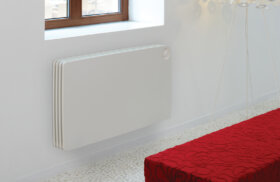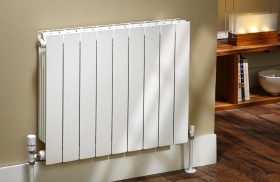Correct placement of a radiator is the first step to creating a warm, inviting space for all to enjoy. In colder climates, keeping the room warm when the outside world is cold will ensure that it’s a welcoming place all year round. The challenge is to place the radiator where it can produce the most heat while reducing the chance of impeding the function and flow of the room. Here are three simple steps for the best radiator positioning to make the most out of your room space and for optimum heat distribution.
Step 1: Assessing the Room
First and foremost, it’s crucial to assess the room in which you wish to install your radiator. Consider the room size, layout and existing heating infrastructure before deciding where to place your radiator. With such a variety of radiators from single panel to double panel, the type of radiator you have chosen will also determine its placement.
Often heating sources are located under windows as this allows the heating source to counteract the cooler air that typically emanates from the window panes. As that air drops, the warmer air rises to meet and mix with it. In buildings with newer, insulated windows, this is not such a challenge. Avoid putting furniture in front of your radiator as this blocks the heat and stops it from being able to travel to other parts of the room. Instead, keep furniture at least 60 centimetres away from radiators so that heat can freely circulate around the room.
Step 2: Determining Heat Requirements
Determining how much heat is required to warm up your room is essential to deciding which radiator to purchase and where to place it. This will also help you to be more energy efficient and save money on energy bills. To estimate your heating requirements, make use of our Heat Calculator – simply fill in your room’s details and it’ll calculate how much heat it needs in Watts.
There are various factors to consider when estimating how much heat you require.
- Room size: If your room is larger and has many windows or gaps for cold air, you will require a higher amount of heat. However, if you plan to place your radiator in a smaller space, it will heat up faster and use less energy.
- Insulation: Your building’s construction and insulation level are important to take note of as a larger building with poorer insulation will need more heat to maintain a comfortable temperature.
- Desired temperature: Lifestyle factors will impact what your desired temperature is, including the amount of time spent at your house. If you work from home, you will use more energy in that particular room, so it makes sense to turn off radiators in rooms you don’t use.
Step 3: Choosing the Ideal Placement
Under windows
If you live in an older home with single glazed windows and poor insulation, it is easier to experience heat loss. So it’s recommended that you place your radiator in the horizontal space under the window. The heat will rise from the radiator, mixing with the cold air coming through the window which in turn will help the radiator’s heat distribute around the room.
In modern homes, windows usually have double glazing so heat is not lost as easily and the area close to the window surface stays much warmer. As a result, if you stay in a newer home you have more flexibility to place your radiator elsewhere.
Along interior or exterior walls
The exterior wall and the window above it are more often than not the coldest spots in the room. Placing your radiator here assists to prevent cold air from entering and instead immediately mixes with the hot air from the radiator. However, placing the radiator on an exterior wall space may reduce its efficiency as it has to work twice as hard to counter the cold from outside. To prevent this, heat output may be better when your radiator is placed on an interior wall.
Placing your radiator on an interior wall means increased efficiency from the insulation of the interior walls. If you have limited wall space, vertical radiators are the best option to maximise your space as they’re tall and slim, but you will also get the maximum heat output.
Avoiding common mistakes:
Putting furniture in front of a radiator
If your sofa is in front of a radiator, it won’t perform as well. This is because the sofa or other furniture item will absorb a lot of heat from the radiator and prevent effective heat circulation throughout the room. Consequently, you will have to turn up the heating for a comfortable temperature leading to higher energy consumption and bills.
Full length curtains
Similar to putting furniture in front of your radiator, full length curtains will restrict the heat from distributing around the room. If you open your curtains and feel some warmth where your radiator is located, it’s likely you’re experiencing a problem. Curtains can also present a fire risk if you have a convector radiator that releases heat from the top.
Behind a door
In some instances, specifically in the case of smaller rooms, positioning a radiator behind a door may be your only option. And while radiators move heat around the room via convection making it less of a problem, this depends on the temperature of the space that the door connects to. For example, if the door leads into a cold hallway, the heat will head straight to the colder area, leaving the room you wish to heat up colder when the door is open.
Chat to us about the best place to put a radiator
Proper radiator placement is crucial for improved heating and cooling, energy efficiency and comfort. When radiators are positioned correctly, not only will they operate better, you will also find you have lower energy bills and longer equipment lifespan. We encourage you to take the above steps to ensure optimal performance of your radiator and lessen the need for it to be replaced.
With the variety of designer radiators that we offer, from horizontal to vertical radiators, you’ll find the perfect fit for your space. Pop by one of our radiator showrooms and chat to an expert about radiator installation and the best place to put a radiator. Remember we offer FREE delivery for orders over £60!





